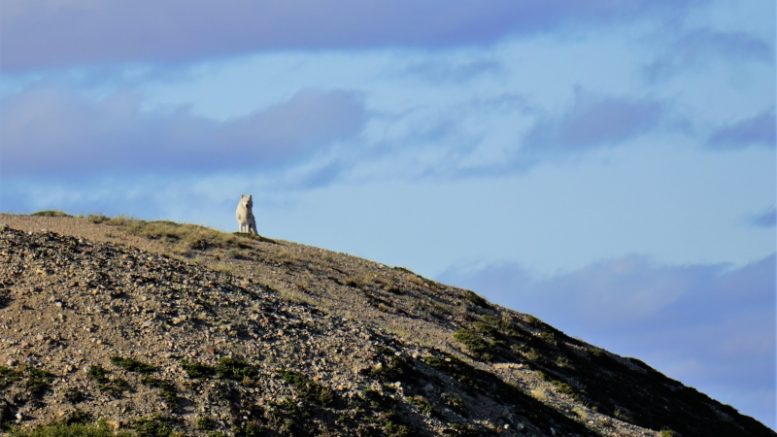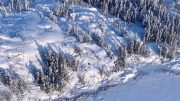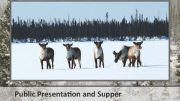The Wekʼèezhìi Renewable Resources Board has recommended stopping a controversial practice of shooting dìga (wolves) from the air.
Instead, it proposes the Tłı̨chǫ and territorial governments put more resources into supporting ground harvesting to try and protect Ɂekwǫ ̀ (barren-ground caribou).
This was one of 20 recommendations the board recently published on the proposed dìga management plan.
Last spring, the territorial government ran a pilot project to shoot dìga from a helicopter to reach reduction targets of 60 to 80 per cent of the population in the Wekʼèezhìi area. The project was proposed as a backup plan if traditional ground harvesting didn’t meet the reduction targets.
The targets still weren’t met, says Jody Pellissey, the WRRB’s executive director.
“(Aerial removals) didn’t appear to get to the target levels that they were hoping to reach for the required program to be considered effective and successful,” she says. “And then along with the significant public concern that we heard… (The board) felt that it was most appropriate to discontinue that part of the wolf management at this time and to concentrate on ground based harvests.”
Overall, 85 wolves were removed as part of the program — 54 within the Bluenose-East range (45 per cent) and 31 for Bathurst (63 per cent). According to the program’s technical report, just under half (41 wolves) were culled from the air
Last year the territorial and Tłı̨chǫ governments increased the incentive payments for dìga harvesters. They also hosted training workshops. CKLB asked both governments what kind of additional support would be needed to increase ground harvesting. The GNWT said it was still evaluating the board’s recommendations. Tłı̨chǫ Government has not yet responded, but Tammy Steinwand, the director of culture and lands, has previously called for more training opportunities for harvesters.
The board pointed towards a 2017 report on dìga management options, which proposes ground supports like gas caching and bait stations, as potential supports to increase ground harvest success.
More data needed
Several other recommendations focused on data collection and monitoring. They ranged from improving harvester feedback surveys, to conducting den studies and calf mortality studies, to developing annual monitoring reports on “efficiency, effectiveness, and humaneness to ensure the dìga management and monitoring program is comprehensively evaluated.”
“The board felt there was limited information available about how many wolves are out there on the tundra,” says Pellissey. “Getting out and collecting data on what their movements are allows for GNWT to better understand what’s happening on the land and then better determine what sort of target should be in place. And that, in turn, makes the program better.”
The territorial government acknowledges there is not much information about dìga populations in the territory.
“The GNWT-Tłı̨chǫ Government joint approach to wolf management has always been adaptive, meaning we recognized from the outset that we would need to be prepared to adjust target numbers to ensure they are within the 60-80% range as new information (scientific, local or traditional knowledge) on wolf numbers becomes available,” says Joslyn Oosenbrug, spokesperson for the department of Environment and Natural Resources.
The proponents of the plan now have 42 days to respond to the WRRB’s decisions.
Asked whether it would reject any of the recommendations, Oosenbrug reiterated that the department is reviewing them. Any recommendations that are rejected or varied need to be accompanied by a reason that will then be reviewed by the board.
Delay in population surveys
Due to COVID-19 travel restrictions, the GNWT did not carry out herd surveys for Kǫ̀k’èetı̀ (Bathurst) and Sahtì (Bluenose-east) ekwǫ̀. The surveys are done over the herds’ calving grounds in Nunavut, and that government put a hold on research applications last summer. ENR’s plan is to do the surveys this summer.
Preliminary results for the Tłı̨chǫ Government’s Ekwǫ̀ Nàxoède K’è (Boots on the Ground) 2020 caribou monitoring program show there were mostly small groups of of about 20 caribou travelling together. Monitors also saw fewer wolves than in previous years.
Francis was a reporter with CKLB from January 2019 to March 2023. In his time with CKLB, he had the immense pleasure and honour of learning about northern Indigenous cultures.








